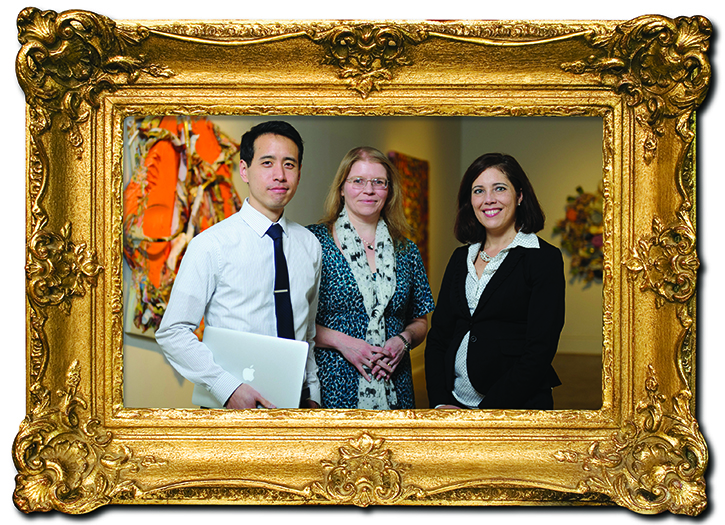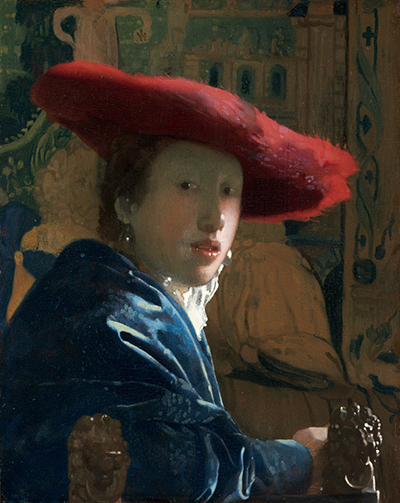
By Terri Robertson and Cathy Butler
Sometimes to teach the importance of the small, one must think large. That was the case when Dr. Tanja Jones, assistant professor of art history, pushed the boundaries of her classroom – both physically and virtually – to create the curriculum for her spring course ARH 373 Baroque Art of Northern Europe.
The subject at hand is small, literally. The class research project focuses on 40 small-format paintings, each no more than 10 inches in height, by artists of the Golden Age of Dutch and Flemish painting in the 17th century. Though small in size, these paintings are significant for their extraordinary precision and detail.
To fully engage her students in the material, Dr. Tanja Jones embarked upon a multi-part collaboration with the Birmingham Museum of Art (BMA) – where the paintings are part of the exhibit “Small Treasures: Rembrandt, Vermeer, Hals, and Their Contemporaries” – and the Alabama Digital Humanities Center (ADHC), part of University Libraries, which developed a complementary website for the class.
The Course Design
ARH 373 Baroque Art of Northern Europe is designed as an experiential learning course, where students will synthesize and present analysis and research on a problem.
“Whether students go on to become curators, engineers or ad executives, in the ‘real world’ one needs to know how to research a problem, analyze relevant data and present findings in a clear and cogent way. This project is designed to aid students in building those skills,” said Jones.
To begin, the students each chose one painting from the exhibit, which they can view on a website specially designed for their class by the ADHC. In February, they had a chance to view their painting in person during a field trip to the BMA.
The next step for the students is a three-part writing assignment about their chosen painting: (1) a formal analysis of the constituent parts of the artwork; (2) an annotated bibliography relevant to the object for research and analysis; (3) label text – three to four paragraphs crafted from steps 1 and 2 that provide readers with an introduction to the object and the literature dedicated to it.
When finished, the students will upload their writing to the website gallery, where their classmates and the public will be able to view their scholarly work.
In late April, selected students will serve as docents for their paintings at the BMA exhibit and share their knowledge with visitors.
The Website

“I was eager to incorporate a web-based component in the project, but did not have the technical knowledge required to create the type of website I envisioned,” said Jones.
Fortunately, the University Libraries’ Alabama Digital Humanities Center is there to support faculty such as Jones in translating their expertise to the digital realm.
Dr. Emma Wilson, post-doctoral fellow, and Muzel Chen, technology specialist, are the team behind ADHC. Wilson has a doctorate in English literature and the history of logic – a background that is particularly helpful for the task of structuring websites – while Chen serves as technical guru. Together they help UA faculty and graduate students make their digital projects happen.
To bring the Small Treasures website to life, Jones, Wilson and Chen met a couple of times over two weeks – first to scope the project, then to work in detail on the structure of the site to ensure it would provide the engagement and activities Jones wanted for her students.
Such meetings are essential to the collaboration process with ADHC because, Wilson explained, “in digital humanities here, we like the capital H to go to the humanities and for digital to really be supplemental. It should never be that you’re doing something for the sake of being digital.”
While a main concern was making the website gallery private to respect copyrights, there were also exciting opportunities to make some components, such as the annotated bibliographies and other student writings, available for the benefit of the general public.
“They (the students) are finding some really useful material, so we thought, why not make those available for the public. It might help them learn more about these works of art, whether they’re going to see the exhibit in person or they’re working on an independent research project,” said Wilson.
Once Chen and Wilson established the framework, Jones and her graduate assistant Emee Hendrickson added titles of works, physical dimensions, the type of painting, professional gallery notes and other things students would need to know to do their work.
The website collaboration will be truly complete when the students upload their final assignments at the end of the semester.
“It’s a really good example, working with these students, where you’ve got a class of x number of people and they can produce so much more collectively than any one of them can in that time frame,” said Wilson.
The Museum Experience
While digital images can come close to the real thing, it’s not the same as seeing an actual object. Thanks to the BMA’s educational outreach efforts and its “Small Treasures” exhibit, students have the rare opportunity to study the masterpieces up close.
“Considering there are fewer than 35 Vermeers in the world, to have two in Birmingham is amazing,” said Jones.
In February, Jones’ class loaded onto a bus for a trip to the BMA, where Dr. Robert Schindler, the museum’s curator of European art, led a behind-the-scenes tour of the exhibit.
The tour ranged in topic from the historical context of the Dutch Golden Age to the process of curating the exhibit.
“Talking to Dr. Schindler was really interesting because we don’t talk about exhibit design in class,” said Erin Hein, a junior majoring in art history and chemistry. “We talked about the layout of the exhibit, the wall text and graphics. This is material we don’t have the time to cover in class, but is directly related to career choices in art history.”
Schindler drew connections between paintings, such as how close similarities in technique and brush strokes could indicate a teacher-student relationship between artists, and pointed to the fingerprint in the corner of Rembrandt’s oil sketch, “A Portrait of a Rabbi,” which could only belong to the master artist himself.
Students were able to see the materials of the 17th-century artist, such as linseed oil, raw plant materials used for pigment and ground pigments held in shells, ready for mixing. Unframed paintings displayed in cases allowed a peek at two common painting surfaces of the era – wood and copper. The shiny, smooth surface of the copper, Schindler pointed out, could be used by an artist to give a painting a luminous inner glow.
And, of course, there was the opportunity to study the paintings for the first time up close and in person.
“Seeing the exhibition definitely gave me a greater insight to the amount of detail and a better sense of scale of these objects,” said junior Kathrine Neal, who chose “Portrait of a Man” by Gerard ter Borch for her project. “I don’t think you can really grasp how small these paintings really are until you see them in person. It’s impossible to view or appreciate them from any great distance.”
The museum experience is the final component of Jones’ collaborative, experiential learning approach to teaching, which will come to fruition on April 21 when her students return to the BMA to share their newfound expertise with others.
“Small Treasures: Rembrandt, Vermeer, Hals, and Their Contemporaries” is on display at the BMA through April 26.
Portions of the ADHC website designed for Jones’ class, smalltreasures.as.ua.edu, are available to the general public; students’ final projects will be viewable by the end of the semester.
